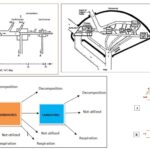Biochemistry 4 Views 1 Answers
Sourav PanLv 9April 18, 2025
What happens during Krebs cycle?
What happens during Krebs cycle?
Please login to save the post
Please login to submit an answer.
Sourav PanLv 9May 15, 2025
During the Krebs cycle, acetyl-CoA (2C) combines with oxaloacetate (4C) to form citrate (6C). Citrate undergoes isomerization to isocitrate, followed by sequential oxidative decarboxylations, producing two CO₂ molecules and reducing three NAD⁺ to NADH and one FAD to FADH₂. A GTP (or ATP) is also generated through substrate-level phosphorylation. The cycle regenerates oxaloacetate in its final step, enabling it to initiate another round. The reduced cofactors carry high-energy electrons to the electron transport chain, which drives ATP synthesis via oxidative phosphorylation.
0
0 likes
- Share on Facebook
- Share on Twitter
- Share on LinkedIn
0 found this helpful out of 0 votes
Helpful: 0%
Helpful: 0%
Was this page helpful?




